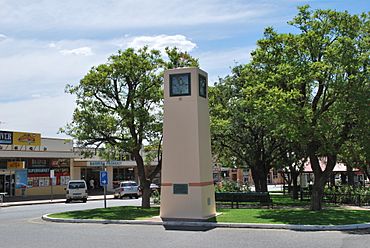Barmera facts for kids
Quick facts for kids BarmeraSouth Australia |
|
|---|---|

The Charles Sturt centenary clock tower, built in 1944
|
|
| Established | 1859 |
| Location | 221 km (137 mi) NE of Adelaide |
| LGA(s) | Berri Barmera Council |
| State electorate(s) | Chaffey |
| Federal Division(s) | Barker |
Barmera is a town in the Riverland area of South Australia. It's about 220 kilometres (137 miles) north-east of Adelaide, the state's capital city. Barmera is known for its farms and vineyards, and it sits right next to Lake Bonney Riverland, a beautiful freshwater lake.
Contents
Barmera's Early History
The first people to live in this area were the Barmerara Meru clan of the Ngawadj people. The name "Barmera" might mean "water place" or "land dwellers." These words likely came from the local Aboriginal language. Some also think the name comes from the Barmeedjie tribe. This tribe lived north of the Murray River long ago.
In 1838, explorers Charles Bonney and Joseph Hawdon were the first Europeans to see Lake Bonney. They were moving cattle along the Murray River. The area officially became settled in 1859. This happened when the Overland Corner Hotel was built.
This spot was very popular with drovers. These drovers moved sheep from New South Wales into South Australia. A police station was also built here. It helped keep peace between the Aboriginal people and the new settlers.
Growing as a Town
In 1921, an irrigation system was set up in Barmera. This helped farmers get water for their crops. The town became officially recognized around this time. After World War I, many soldiers were promised irrigated land by the government. They came to settle in Barmera.
A railway station opened in 1928, making it easier to travel and transport goods. Barmera was officially declared a town in the same year. During World War II, a large camp was built near Barmera. It was in a place called Loveday. This camp housed people who were considered a risk during the war. It was one of the biggest camps of its kind in Australia.
Special Places in Barmera
Barmera has some historic sites that are important to its past. These places are protected because of their heritage.
- Bonney Theatre: This old theatre is at 2-4 Barwell Avenue.
- Barmera Irrigation Office: You can find this building at 2 Fowles Street.
- Napper's Accommodation House Ruins: These ruins are on North Lake Road.
Barmera's Climate and Land
Barmera is in a semi-arid (dry) area. This means it doesn't get much rain. It is north of an imaginary line called Goyder's Line. This line shows where farming becomes difficult due to low rainfall. The town is surrounded by mallee scrub. This is a type of bushland with small, multi-stemmed trees.
Barmera is about 29 metres (95 feet) above sea level. It has hot summers. Winters have warm days but cold, frosty nights. The temperatures are a bit warmer than in Adelaide. They are similar to those in nearby Berri. Barmera gets less than 250 millimetres (10 inches) of rain each year. The amount of rain can change a lot over a 19-year period.
Life in Barmera Today
Lake Bonney is a big part of life in Barmera. It has sandy beaches and a jetty. People enjoy fishing and sailing on the lake. Every Easter, a sailing competition is held there. A country music festival takes place every June.
In September, the Riverland Field Days are held. This event showcases farming and agricultural technology. A local Show is also held in March. Barmera has its own sports teams. These include the Barmera/Monash Roos Football Club and the Barmera United Soccer Club.
Barmera is part of the Berri Barmera Council. This is its local government area. For state government, it's in the electoral district of Chaffey. For federal government, it's in the Division of Barker.


